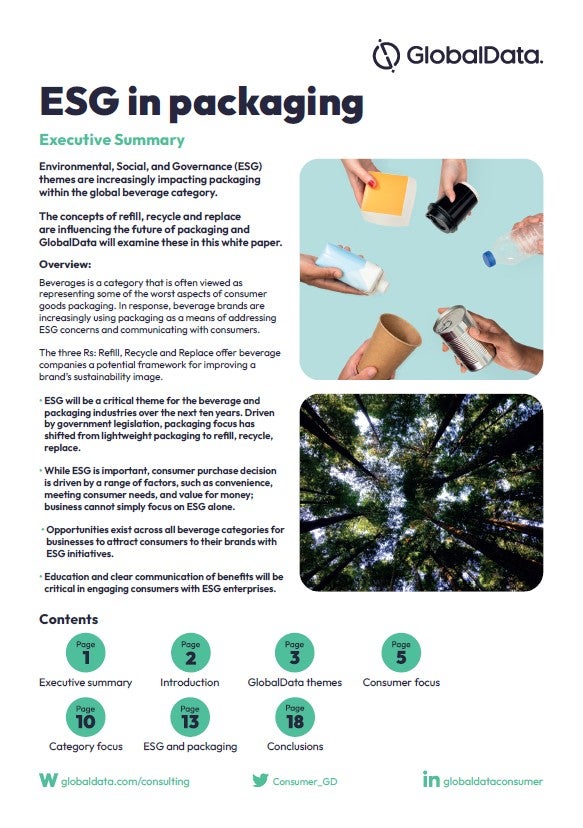
In today’s packaging industry, the pressure to reduce environmental impact is a key challenge, particularly within logistics.
Mark Haslam, Logistics Director for Europe, the Middle East, and Africa (EMEA) at Ball Corporation, sheds light on the company’s innovative logistics strategy.
How well do you really know your competitors?
Access the most comprehensive Company Profiles on the market, powered by GlobalData. Save hours of research. Gain competitive edge.

Thank you!
Your download email will arrive shortly
Not ready to buy yet? Download a free sample
We are confident about the unique quality of our Company Profiles. However, we want you to make the most beneficial decision for your business, so we offer a free sample that you can download by submitting the below form
By GlobalDataHaslam brings unique insights into how Ball is tackling sustainability head-on without waiting for the perfect solutions to materialise.
A multipronged approach to reducing environmental impact
Ball Corporation, a global leader in sustainable packaging, has developed a comprehensive strategy to minimise the carbon footprint of its logistics operations.
Haslam emphasises that this strategy is far from one-size-fits-all; it involves a multipronged approach tailored to the varying needs of different regions and customers.
“Our first approach is, why move it?” Haslam explains.
“The second approach then is to look at the total supply chain, so we work then with our customers and our 3PLs [third-party logistics] and understand what is the best solution.”
When transportation is necessary, Ball Corporation explores a range of options to minimise environmental impact.
“We work with our customers and third-party logistics providers to determine the best solution, whether that’s intermodal transport using rail, electric vehicles, or alternative fuels like hydrotreated vegetable oil [HVO],” says Haslam.
“If intermodal is not suitable, then we look at the type of vehicle that we would have for that customer. That might be the engine, so it could be electric. It could be the fuel within diesel engine, which could be HVO. It could be hydrogen. […] We’ve got natural gas vehicles as well,” says Haslam.
“And it’s not just the front end, the tractor unit, it also could be the trailer. So, we also have longer trailers and higher trailers.”
The role of HVO in Ball’s decarbonisation strategy
One of the key components of Ball Corporation’s sustainability efforts is the adoption of HVO.
This renewable fuel, derived from waste oils and fats, offers a significant reduction in carbon emissions compared to traditional diesel.
In the UK, HVO is becoming the standard, and Haslam sees it as a crucial stepping stone towards the company’s long-term goals.
“We’ve always seen HVO as a bridge. We’re not saying it’s the panacea. We’re not saying it’s the final solution to sustainability. What we want to do is get to electric or possibly hydrogen trucks in the future. But currently there’s a gap in terms of supply of electric trucks, there’s a gap in terms of the range, there’s a gap in terms of price, which can be very significant,” explains Haslam.
“So, what HVO does, it’s a drop-in fuel. You can put it into a normal diesel engine, and there’s no need to do any modifications to the vehicle itself, and it doesn’t have any negative impact on the vehicle’s performance.”
However, the availability of HVO varies across regions.
Haslam points out that while Western Europe has a relatively strong supply of HVO, other regions face significant challenges in sourcing the fuel.
“If I look at the UK, and I look at Western Europe, there’s a really good supply, but when we get further east, we find there isn’t that supply. In one region, it’s about working with a customer, running the project, measuring it very clearly and carefully, and feeding back. In another region it’s actually just trying to find a source.”
Collaborating with 3PLs to drive sustainability
Ball Corporation’s relationship with its 3PL partners is central to its logistics strategy.
Haslam understands the importance of collaboration and alignment in driving sustainability.
“We have a qualification process that brings our 3PLs into our business. We have regional seminars and workshops where we’ll bring them together and we’ll work with them,” says Haslam.
“And for our top 20 3PLs, we run an awards process, and we measure them on service, we measure them on efficiency. We also measure them on sustainability and what we try and do is share best practice.
“We bring our best 3PLs together, and we get them in a very collaborative and open forum to say: What are you doing? How are you working on sustainability in Poland, versus how are you doing it in Spain versus how are you doing it in Finland? Because there’s so many different models.”
This collaborative approach extends beyond just logistics.
Haslam highlights how discussions about sustainable logistics often lead to broader conversations about sustainability across the supply chain.
“It becomes a wider discussion, because what we’re actually doing then is you say, while we’re on it, what about solar panels on the roof of warehouses? […] What are you doing in terms of other factors? So, what comes out of a logistic sustainability discussion can become a more holistic discussion about sustainability.”
Overcoming infrastructure and policy challenges
The transition to more sustainable logistics is not without its challenges.
The lack of infrastructure for electric vehicles and inconsistent government policies across different regions are significant hurdles.
Haslam explains that while Ball Corporation has a roadmap to 2030, achieving these targets will require collaboration with governments and industry partners.
One example of successful government collaboration is in Denmark, where the road pricing incentivises lower CO2 emissions and therefore provides a broader and more holistic incentive than solely focusing on electric trucks.
“A good example is Denmark. I’m not saying we’ve created this, but in Denmark what we’ve got with the Danish government is from January of next year. Their road pricing will come in, but it will incentivise electric trucks. That’s a really good example where we’re really happy that happened and then we work with our largest Danish 3PLs and we say, look at this incentive now for us to drive forward.”
Navigating logistics in less connected regions
While Europe’s well-connected infrastructure facilitates cross-border logistics, Ball faces significant challenges in less connected regions such as Africa and the Middle East.
The company’s operations in Egypt, for example, have been complicated by geopolitical instability, particularly in relation to shipping through the Suez Canal.
As a result, Ball has had to shift from maritime to road transport, which presents additional logistical difficulties.
Furthermore, in regions such as Turkey, the availability of sustainable transportation options such as electric or HVO-powered trucks is limited.
Ball is actively working with its 3PL partners in these regions to introduce more sustainable solutions, albeit acknowledging that this process will take time.
The company is committed to pushing its logistics partners towards more sustainable practices, recognising that this requires persistent engagement and investment.
Aligning logistics strategy with Ball’s Climate Transition Plan
Ball’s logistics strategy is deeply aligned with its Climate Transition Plan, which emphasises transparency, the use of proven technologies, and strategic partnerships.
Central to this alignment is the use of data, specifically through the company’s transport management system (TMS).
The TMS tracks every kilometre travelled by Ball’s transport fleet, detailing the type of fuel used – be it diesel, HVO, or electric.
This granular data collection allows Ball to accurately measure its carbon footprint and make informed decisions about reducing emissions.
The data also feeds into Ball’s broader corporate reporting, ensuring that the company’s logistics operations are in line with its Science Based Targets initiative targets.
“Data is key. Reporting up is key and whatever we do from our logistics plan and point of view feeds into our global plan. That’s then audited and reported back,” emphasises Haslam, noting that detailed reporting not only supports Ball’s sustainability goals but also enhances transparency with customers, who are increasingly interested in understanding their scope 3 emissions.
The future of sustainable logistics
Looking ahead, Haslam sees the widespread adoption of electric and hydrogen trucks as inevitable, but he stresses the need for pragmatism in the meantime.
“Let’s not wait for that perfect solution. Perfection is the enemy of progress,” he says.
“We look at all these options, we don’t rule anything out, but HVO, what we see in many of our markets, is an ideal solution for accelerating decarbonisation and driving forward our agenda to get to our own targets.”
Ball Corporation’s approach to sustainability in logistics is a testament to the power of collaboration, innovation, and pragmatism.
By leveraging a range of solutions tailored to different regions and working closely with 3PLs, customers, and governments, Ball is making significant strides in reducing its environmental impact.




